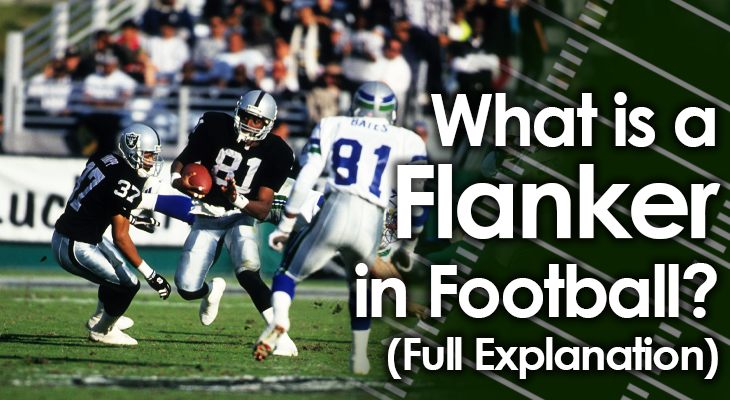People use position groups to categorize players into buckets of similar players.
All offensive linemen, for example, will need to block and protect the quarterback on every play -- whether they are a center, guard, or tackle.
Similarly, there are multiple types of wide receivers in today's game.
And while each of these receivers have the same generic responsibilities -- run routes, catch passes, and block on running plays -- the different types of receivers all operate in completely different ways.
One of those is what's known as the "Flanker."
Below, we'll break down what a Flanker in football is, how they are made up, and what they're asked to do on the football field.
What is a Flanker in Football?
A Flanker in football is a type of wide receiver.
They will always start plays lined up a few yards off the line of scrimmage.
In this case, he'll technically be lined up in the backfield. He will be one of four players who won't line up at the line of scrimmage.
On most plays, the Flanker will start on the strong side of the field. If there's a tight end on the field, he will be on the same side as him.
On plays that don't have a tight end, the Flanker will line up on the side that matches the quarterback's "handedness," i.e. the right side for a right-handed quarterback and vice versa.
The Flanker will give himself some space width-wise from the last offensive linemen at the LOS and the outside wide receiver who will be closer to the sideline and at the LOS as well.
In some formations, that separation may not be equal on both sides, especially if the offense is running a Trips formation.
When offensive coaches sketch out plays, the Flanker is usually represented by a Z, though some coaches may decide to label them FL.

What Does a Flanker Do?
Like all other wide receivers...
A Flanker will need to run routes on passing plays and provide outside blocking support on running plays.
That's just a general description, though.
On many plays, the Flanker will go in pre-snap motion. This gives the offensive coach the ability to move this player around before the snap, which can create even more separation between him and his defender.
It could also create big-time mismatches if the defense decides to switch coverage on him from a cornerback to an outside linebacker, for instance.
The motion can also help offensive coaches and QBs identify the coverage they'll be facing on the play from the defense in real-time. This could provide the offense with a major advantage as they're trying to find an opening for big gainers.
On passing plays, the Flanker isn't typically the primary target for the quarterback. That title usually goes to the team's #1 receiver, which is usually one of the outside receivers.
Because of this, the Flanker will run a lot of routes designed not only to get him open for passes but to also cause distractions among the defense or to clear out space for the offense's primary targets.
An example might be to have the Flanker run a quick Out route or a Slant route toward the middle of the field that's designed to draw defenders away from where the main receiver lines up. This could help the #1 receiver face one-on-one coverage and get a mismatch more often.
However, this doesn't mean that the Flanker can't catch passes...
There are many Flankers in NFL history who have established themselves as major pass catchers -- players such as Wes Welker and Julian Edelman.
Even NFL powerhouses such as Odell Beckham, Larry Fitzgerald and Anquan Boldin could also be considered Flankers at some point.
Flanker Body Type:
Since the Flanker will not be at the LOS, it's not as necessary for him to be as big and strong as the team's outside receivers.
Many Flankers are on the "smaller" end -- both in height and weight. They counteract this size disadvantage by being extremely speedy and shifty.
This will be very important to their game, based on what they usually need to do on most plays.
Because they are still wide receivers, Flankers obviously must have the ability to catch passes.
But, since the routes they typically run are of the "quick-hitter" variety, they must have great hands and top-notch hand-eye coordination.
These will come in handy as they will often receive passes in tight spaces and in shorter time periods.

Conclusion
The Flanker in football is one type of wide receiver.
This position will usually be on the smaller side, but will make up for it with speed, quickness, and excellent route running ability.
This position will line up in the Slot on the field and off the line of scrimmage. This gives him plenty of opportunities to start the play in pre-snap motion to create mismatches.

